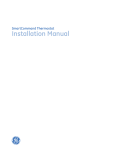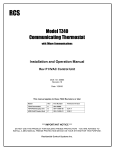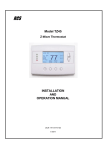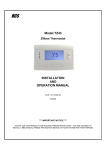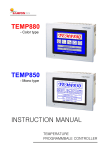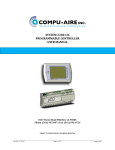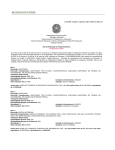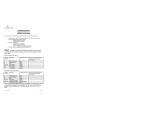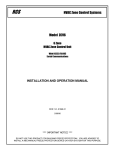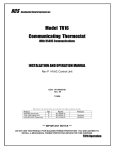Download RCS TS40 System information
Transcript
RCS Model TR40 Thermostat with Serial RS232/485 Communications Installation and Operation Manual PN: 141-01070 Revision 03 Date: 5/22/03 Applies to these TR40 Revisions or later Model Part Number Firmware Version TR40-232 001-01070-07 TR40-485 001-01080-07 TS40 WDU 001-01060-07 3.05.5 HFR-232 CU 001-00810-07 3.04.3 HFR-485 CU 001-00820-07 3.04.3 *** IMPORTANT NOTICE *** DO NOT USE THIS PRODUCT FOR BUILDING FREEZE PROTECTION! YOU ARE ADVISED TO INSTALL A MECHANICAL FREEZE PROTECTION DEVICE ON YOUR SYSTEM FOR THIS PURPOSE. Residential Control Systems Inc. DCN: 141-01070-03 TR40 Thermostat Manual 2 OPERATION The TR40 Thermostat provides typical thermostat functions as well as the capability to send and receive information via serial communications. This communications capability allows the thermostat’s setpoint, mode and fan operation to be changed remotely. In addition, the remote systems can request status of the thermostat’s temperature, setpoints, modes, and other system information. The thermostat consists of two parts, a Wall Display Unit (WDU) and a HVAC Control Unit. The Wall Display Unit looks like a traditional thermostat and is the wall mounted user interface for the TR40. It provides display, control pushbuttons, and the temperature sensor. The WDU connects to the Control Unit by a 4 wire cable. The Control Unit connects to the HVAC system in place of a standard thermostat and provides thermostatic control of the system. In addition, the Control Unit sends and receives data and commands via a twisted pair serial communications connection for remote control of the system. The Model TR40 can be used with up to 4 remote temperature sensors such as the RS15. TR40 Wall Display Unit The WDU has a backlit LCD graphical display, control buttons, LEDs and a digital temperature sensor. The WDU can display multiple screens. In the default thermostat screen, it shows the current temperature, setpoint, mode and manual fan mode, time, outside temperature and other information. Any changes in temperature, or control button operations, are transmitted to the Control Unit. Updates are received from the Control Unit and displayed by the WDU. TR40 WDU Thermostat Screen 10:25 Sys Off Econ Run No Msg Indicator LEDs MENU Outside 60 75 MODE FAN 76 H 74 C Setpoint Up/Down Buttons RUN Large Graphical LCD Screen On-screen dynamic labels Function Control Buttons Wall Display Unit Display The TR40 display is a graphical LCD display capable of both text and graphics. The WDU has multiple display “screens”. The main screen is the thermostat screen shown above. This screen has a “minimized” mode in which only the temperature is displayed. It reverts to this minimized mode after a timeout delay period. Other standard screens are selected by the Menu button and include: Messages, Schedules, User Settings, and Thermostat Info. Others may be present and selectable from the menu button in special versions of the WDU. DCN: 141-01070-03 TR40 Thermostat Manual 3 The TR40’s LCD features a backlit display for low light and night visibility. It can be set to remain on constant or to turn out after a 20-45 second delay . DCN: 141-01070-03 TR40 Thermostat Manual 4 OPERATION Wall display Unit Control Buttons All 6 buttons on the TS40 Wall Display Unit are “Soft Keys” meaning that they change functions when you change screens. The function of the buttons is defined by “on-screen labels” that are dynamic and change when you change screens. The following are definitions for the buttons for the main “Thermostat screen” and their primary mode of operation. Other screens and their button operations are defined in following sections. Wall Display Unit LEDs The TR40 has four LED’s that display various status information. The LEDs have dynamic “on-screen” labels that can change with the screen being displayed. Wall Display Unit “Screens” One of the unique features of the TS40 WDU graphical display is the ability to have multiple display screens. In addition to a main thermostat screen, menus and other control screens for special functions are provided. This makes an intuitive and easy to use “user interface”. It allows the many functions of the TR40 to be easily navigated. You move to other screens by pressing the Menu button from the main thermostat screen. A new Main Menu “screen” will be displayed with a list of menu functions. When a menu item is selected, a new “screen” will be displayed for that function. Refer to the individual screen descriptions that follow for details on navigating each screen. The Minimized Main Thermostat Screen The main thermostat screen will go to a “minimized” screen after a timeout period. This presents a simple uncluttered display of the current room temperature and outside temperature (if an OT sensor is attached). Pressing any button causes the full Main Thermostat screen to be restored and displayed. Screen Timeouts When you menu to other screens, you have the option of exiting those screens to return to the main thermostat screen or just waiting until the automatic screen timeout occurs that will return the display to the main thermostat screen. The main thermostat screen normally reverts to the minimized screen after 30 seconds. This can be adjusted from 15 to 120 seconds in the User Settings Menu under Screen Timeout. You can also set the timeout period to “0”. In this case the Main Thermostat screen will NEVER timeout and revert to the minimized screen. DCN: 141-01070-03 TR40 Thermostat Manual 5 Main Thermostat Screen 10:25 1 2 3 4 Sys Off Economy Run No Msg MENU Outside 60 75 MODE FAN 76 H 74 C RUN The main thermostat screen is the default display screen and is the screen that is normally displayed on the Wall Display Unit. It will revert to a minimized screen after 30 seconds of display. Temperature Display The WDU will normally display the current temperature from the internal digital temperature sensor or a remote sensor. The sensors have an accuracy of +/- 1°F(+/- .5°C). The WDU will display temperatures from -63°F to 191°F. NOTE: If averaging remote sensors are attached, the display will show the average temperature of the sensors. Setpoint Display The heating and cooling setpoints are displayed next to the Setpoint Up/Down buttons. In the HEAT mode, the Up/Down buttons change the heat setpoint. In the COOL mode, they change the cooling setpoint. When in AUTO mode, the buttons change the last call’s heating or cooling setpoint. Note that the setpoints will “push” each other if they are adjusted to get within the minimum Heat/Cool separation (delta T) setting. This is normally 3 degrees. Clock Display The current time is displayed in the upper left corner of the main screen. Outside Temperature Display The outside temperature is displayed in the top center of the main screen, if outside temperature information has been sent to the thermostat or a remote temperature sensor is connected to the WDU. Main Thermostat Screen Buttons UP and DOWN Buttons The UP and DOWN buttons control the setpoint temperature. DCN: 141-01070-03 TR40 Thermostat Manual 6 Pushing the UP button will increment the setpoint value by one degree and conversely, pushing the Down button will decrement the setpoint one degree. Pushing and holding a button down will cause the setpoint to continuously change until the button is released. Main Thermostat Screen The setpoint can be set from 40°F to 99°F ( 5°C to 37°C), unless limited in the Installer Settings. Main Thermostat Screen MENU Button The Menu button changes the screen display to the MAIN MENU screen which show what other functions are available on the Thermostat. These are dynamic and can change with the version of the thermostat you have, but the standard ones include: Main Thermostat Screen Menu Button q Main Menu Screen § Messages § Schedules § User Settings § Thermostat Info MENU OFF MODE AUTO FAN RUN Main Thermostat Screen MODE Button The MODE button controls the HVAC system mode. The current mode selected is displayed above the button. Pushing the MODE button will cause the mode and display to change to the next mode. The system mode cycles from Off to Heat to Cool to Auto and back to Off again with each push of the MODE button. When the HVAC system type is set to Heat Pump, the mode selection will include EH for Emergency Heat mode. Mode Button § Off § Heat § Cool § Auto § EH MENU OFF MODE AUTO FAN RUN Off Mode: System is off. No heating or cooling will come on. Heat Mode: Only heating will occur. Cool Mode: Only cooling will occur. Auto Mode: Heating or cooling will come on according to the heating and cooling setpoints. The system will automatically switch between heating and cooling when the temperature exceeds the setpoints. Note that you cannot lower the cooling setpoint below the heating setpoint. The thermostat will “push” the heating setpoint lower if try to lower the cooling below the heating setpoint. It maintains a 3 degree separation between the heating and cooling setpoint. The same is true for DCN: 141-01070-03 TR40 Thermostat Manual 7 raising the heating setpoint above the cooling setpoint. Again the thermostat will “push” the cooling setpoint up to maintain the 3 degree separation. EH Mode: Only available when Heat Pump HVAC System type is selected. When there is a compressor failure with the heat pump system, setting the mode to EH will allow the supplemental heat to come on whenever there is a heat call to provide heating. It also disables the compressor outputs to prevent further damage to the system. Main Thermostat Screen Main Thermostat Screen FAN Button The FAN button controls the HVAC system’s manual fan. The current manual fan mode is displayed above the button. Normally this button is in the Auto mode. Pushing the FAN button once will turn the manual fan operation On. Pushing it again will turn the manual fan off and return to the Auto mode (which means OFF unless turned on by the furnace or AC). Changes in the fan mode are sent to the Control Unit. MENU Fan Button § Auto § On OFF MODE AUTO FAN RUN Main Thermostat Screen RUN/HOLD Button The RUN/HOLD button controls the automatic schedule operation. In the HOLD mode, the current temperature is maintained until changed by manual or remote network command. In the Run mode, the schedule loaded into the thermostat is activated and setpoints will change according to the schedule and the time and day of week. There is also an AWAY mode that you can select if you press and hold the button for 3 seconds. In the Away mode, preset Heating and Cooling setpoints are used. Run Button § Run § Hold § Away (Press and hold button) MENU OFF MODE AUTO FAN RUN Main Thermostat Screen LED Displays The Main Thermostat screen has the following LEDs, numbered from top to bottom, 1-4. o LED 1 o o o o Green: System Operation display. LED Off, “SYS OFF” displayed > HVAC system is OFF LED Off, “SYS MOT” displayed > Minimum Off Time (MOT) delay on is active LED On, “SYS ON” displayed > HVAC System is running LED On, “SYS MRT” displayed > Minimum Run Time (MRT) delay off is active o LED 2 o o o Green: System Economy Mode display LED OFF or On, “Econ” displayed > Economy or 1st stage heating or cooling only LED On, “2nd Stg” displayed > Stage 2 heating or cooling is active LED On, “3rd Stg” displayed > Stage 3 heating is active DCN: 141-01070-03 TR40 Thermostat Manual 8 o LED On, “Vent” displayed > fresh air venting is active o LED 3 Green: Run/Hold display. Shows state of Schedule Run/Hold Mode. o LED Off, “Run” displayed > Schedule is running o LED On, “Hold” displayed > Schedule is off, temperature setpoint hold in effect. o LED 4 RED: Alert LED. Used for Messaging and other system alerts o LED Off, “No Msg” displayed > No text messages or Alerts present o LED On, Mail icon or Alert Text displayed > Message waiting or specific alert text “Communications Error” Display If the WDU is not properly wired or if communications to the Control Unit is interrupted, the LCD display will display “Communications Failure” at the top center of the Main Thermostat Screen (where outside temperature is normally displayed) . Momentary display of “Communications Failure” caused by loss of data, will clear automatically when data communication is restored. If the “Communications Failure” display stays on, check wiring or control unit for problems. DCN: 141-01070-03 TR40 Thermostat Manual 9 Main Menu Screen The TR40 Thermostat has a menu tree that can be accessed by pressing the “Menu” button on the Main Thermostat screen. Various configurations of the TR40 can have different screen contents. The first screen that will come up is the Main Menu screen that list the other menus or functions that can be accessed. Standard screens are listed below. Message Screen This is a text messaging subsystem that allows message of up to 80 characters to be sent to the thermostat. Message that are received are displayed when the message screen is selected. Schedules Screen This screen is used to set the programmable setback schedules of the thermostat. User Settings This screen is used to set the Clock, Screen Timeout, F/C mode and Sensor Calibration functions. Sensor Calibration Screen This screen is used to change the calibration of the thermostat to display the desired temperatures. Also will allow calibration of any remote sensors attached to the thermostat. Thermostat Info Screen This screen shows the firmware versions of the WDU and Control Unit, HVAC system type and equipment options, and the Network address. Menu Selection Messages Schedules User Settings Thermostat Info Done Select Main Menu Screen navigation buttons: Done Return to Main Thermostat Screen Select Select Menu Item Scroll Up to next item Scroll Down to next item DCN: 141-01070-03 TR40 Thermostat Manual 10 Main Menu > Messages The TR40 Message Screen allows you to retrieve text messages sent from the serial network to the thermostat. The message screen features navigation buttons to read new and old messages and delete them. Up to 16 messages can be stored in the thermostat, if more than 16 messages are received, the oldest is erased to make room for the newest message. New messages will turn on and flash the Message LED and Mail Icon in the main thermostat screen. Viewing messages makes them “old” and turns off the indicators. If you view some, but not all new messages, the new message notification LED and icon will stay on. Messages are entered as most recent message as number 1 message. Message Screen Messages Message 1 10/14 5:35 PM The TR40 can receive 16 text messages, each up to 80 characters long. They are date/timed stamped. Done Del Prev Next Message Screen navigation buttons: When you first select the Message Screen, the most recently received message will be displayed as Message 1. If other messages are stored in memory, they can be recalled and viewed or deleted by using the message memory navigation buttons. Done Del DCN: 141-01070-03 Return to Main Menu Screen Delete the Message being displayed Prev Display previous message. Scroll up in message stack Next Display next message. Scroll down in the message stack TR40 Thermostat Manual 11 Main Menu > Schedules The Schedules Screen allows you to review and set the setback schedule for the thermostat. The TR40 has 4 x 7 schedule. Four times a day can be selected for Heating and Cooling setpoints. Each day of the week can have a different schedule. Groups of days can be copied with the same schedule. When the TR40 is set to “Run” mode, the schedule will be executed daily, with the setpoints being changed as per that days schedule stored in the thermostat. “Hold” mode stops schedule operation and holds the current setpoints until changed manually or by network commands. The schedules Screen gives you the option of setting an custom setback schedule or to load one of two preset schedules. Menu Options • Heat and Cool: You can change the individual day/hour and setpoints for the Heat and Cool schedule by selecting this menu item. • Preset: Comfort: This is a preset schedule with mild setbacks. Select this menu item to load the Comfort schedule into the thermostat. • Preset: EnergyMiser: This is a preset schedule with deeper setbacks. Select this menu item to load the Energymiser schedule into the thermostat. Schedules Screen Select Schedule Heat and Cool Preset: Comfort Preset: EnergyMiser Select Done Done Return to Main Menu Screen Select Select the schedule to view or modify DCN: 141-01070-03 TR40 Thermostat Manual 12 Main Menu > Schedules > Heat and Cool Schedule Screen When you select the Heat and Cool Schedule menu item, the Schedule programming screen opens and the schedule for current day will be displayed. Use the scroll buttons to highlight the data to be modified. Once the data has been highlighted, use the +/- buttons to change the value of the data. To copy a days schedule to another or group of days, move the cursor to “c” on the bottom right of the schedule screen. When you highlight “c”, the button below will become “Copy”. Press this button to change to the Copy Schedule Screen. Morn Day Eve Nite Monday Time 6:00 A 9:00 A 5:00 P 10:00 P Schedule Heat Cool 72 82 68 84 74 76 70 78 Done + _ c Next Schedule Screen navigation buttons: Return to Main Menu Screen Done Scroll Back Scroll Forward Next Copy + Select the next Day schedule OR if the copy “c” is selected, go to copy schedule screen. Increase the time or temperature selected Decrease the time or temperature selected DCN: 141-01070-03 TR40 Thermostat Manual 13 Main Menu > Schedules > Heat and Cool > Copy Schedule The Copy Schedule screen is a sub screen of the Schedule screen. The Copy Schedule screen allows you to copy a day’s schedule to another day or group of days. First select the day to be copied in the Schedule screen. Scroll to the “c” at the bottom of the Schedule screen to highlight it. The “Next” button will change to the “Copy” button. Press the “Copy” button to open the Copy Schedule screen. Scroll through the days and select the days the schedule is to be copied to by setting the “N” under each day to “Y” by using the Yes/No buttons. After selecting all the days desired, press the “Copy” button. Exit the Copy Schedule screen with the “Back” button. Copy Schedule Screen Copy Monday Schedule to Yes Sun Tue Wed Thu Fri Sat N Y Y Y Y N Back No Copy Copy Schedule screen navigation buttons: Back Return to Schedule Screen Move back with selection bar Move forward with selection bar Copy DCN: 141-01070-03 Copy the schedule to the selected days Yes Copy schedule to this day No Do not copy schedule to this day TR40 Thermostat Manual 14 Main Menu > User Settings The User Settings screen allows you to set or change various user options of the thermostat such as the clock, timeouts, Fahrenheit/Celsius mode or sensor calibration. Menu options: • Set Clock Select this menu item to go to the Clock setting screen. • Screen Timeout This sets the time before the current screen times out and returns to the minimized screen. If the time is set to 0, the current screen will not time out and will stay displayed until another screen is selected. Options are 0, 15-127 seconds. Select menu item and adjust value with +/- buttons. • F/C Select Select which temperature display mode you desire, Fahrenheit (F) or Celsius (C) with +/- buttons. • Sensor Calibration Select this menu item to go to the Sensor Calibration screen. • Backlight Timeout The LCD backlight can be always on or set to timeout and go off after a preset timeout time. The timeout time can be adjusted from 0 (always on), or 20 to45 seconds before going off. Use +/- buttons to set time desired. Default set to 30 seconds. User Settings Set Clock Screen Timeout F/C Mode Sensor Calibration Done Done + _ Select DCN: 141-01070-03 _ + Return to Main Menu Increment value Decrement value Select the function to be set TR40 Thermostat Manual 60 F 15 Select Main Menu > User Settings > Set Clock The Set Clock screen allows you to set the system clock. To set the Time and Day, move the cursor with the navigation arrows until the data you want to change is highlighted. Using the + and – arrows to increment or decrement the data to the desired setting. When finished, press the SET button to return to the Main Menu screen or wait for screen to timeout. NOTE: If the clock has been reset by an extended power outage, the Clock display on the thermostat screen will be blinking. Pressing the MENU button will take you directly to this screen to set the clock. Set Clock Screen Set Clock Time Date Day + _ 12:00 PM 7/13/03 Thu Set Set Clock Screen navigation buttons: Not Used Move back with selection box Move forward with selection box Set + Set the time Increment Time/Day Decrement Time/Day DCN: 141-01070-03 TR40 Thermostat Manual 16 DCN: 141-01070-03 TR40 Thermostat Manual 17 Main Menu > User Settings > Sensor Calibration The Sensor Calibration screen allows you to change the temperature calibration for the internal and any external remote temperature sensors attached to the TR40 WDU. You can change the temperature calibration by +/- 7 degrees. When the Sensor Calibration screen is selected it will show the internal and all detected remote sensors. Each sensor found will show the current temperature ((75) in the example screen below) and the current number of degrees of offset being applied (1 deg in the example). N/a means that no remote sensor is attached. If the sensor’s actual temp is (74) with 0 degrees of offset and you want it to be 75, then press + to add 1 deg and it will show (75). To change the temperature calibration, use the scroll buttons to select the internal or a remote sensor. Once selected, use the + and – buttons to change the temperature calibration to the desired setting. The value shown in the (xx) is the calibrated or offset temperature that you want the sensor to show. Sensor Calibration Screen Sensor Calibration Internal Remote 1 Remote 2 Remote 3 Done (75) n/a n/a n/a 1 0 0 0 + Sensor Calibration navigation buttons: Done + Return to Main Menu Screen Increase the temperature by 1 deg Decrease the temperature by 1 deg Not used Scroll Up DCN: 141-01070-03 Scroll Down TR40 Thermostat Manual 18 DCN: 141-01070-03 TR40 Thermostat Manual 19 Main Menu > Thermostat Info The Thermostat Info screen displays the current configuration of the Thermostat Wall Display Unit and the HVAC Control Unit. This information is useful for quick check of firmware versions and HVAC system setup. It also shows the network address setting. Thermostat information displayed is: • • • • • • Wall Display Unit Type and Firmware version number. Control Unit Type and Firmware version number. System Type setting: Standard or HP HVAC system Fan Type setting for Standard systems: No Fan w/heat (Gas systems) or Fan w/heat (Electric systems) OR Changeover setting for Heat Pump systems: Changeover with cool or changeover with heat. Network address setting: 1-254 valid When finished viewing this screen press the Done button to return to the main Menu screen or wait for screen to timeout. Thermostat Info Screen Thermostat Info TS40R Ver: 03.05.5 Controller Ver: 03.04.3 System Type: Standard Fan Type: No Fan w/HT Network Address: 01 Done Thermostat Info Screen navigation buttons: Done DCN: 141-01070-03 Return to Main Menu screen. TR40 Thermostat Manual 20 Main Menu > Installer Settings (Hidden Screen) The Installer Settings screen is a hidden screen designed for installer use only. Do not change any settings in this screen unless you are qualified service personnel. Changing these settings will affect the operation of the heating/cooling system. To enter this screen, go to the main menu selection screen and press and hold the two inner buttons for 3 seconds until the Installer Settings screen appears. This screen displays the current internal settings of the thermostat. You can view and change the settings from this screen. The Installer Settings that can be adjusted are: Network Address Sets the serial communications network address. 1-254 valid. Service Mode Sets the thermostat to a test mode. All delays are shortened to 15 seconds to speed up system checkout and testing. Caution: compressor short cycle protection is lost in this mode. Minimum Run Time Sets the minimum run time before a heating/cooling cycle can turn off. 1-9 Min Minimum Off Time Sets the minimum off time before another heating/cooling cycle can begin. 1-9 Min. Auto Send Mode Sets the thermostat to automatically send changes when the occur, out the serial network connection. Max Heat SP Sets the maximum heating setpoint that is allowed. Will not ramp or accept setpoints higher that this maximum. Min Cool SP Sets the minimum cooling setpoint that is allowed. Will not ramp or accept setpoints lower than this minimum. Delta T Settings This is a submenu of the delta, or difference between, the setpoint and current temp for determining when a heat or cool call comes on. Deltas are the number of degrees away from setpoint. Delta T Settings Submenu • H/C Delta Minimum separation between heating and cooling setpoints. Setting a setpoint closer that this delta will “push” the other setpoint higher (heat) or lower (cool). When the thermostat is in the AUTO mode, this maintains a sufficient separation between setpoints to prevent overshoot from causing auto-changeover and subsequent alternating heating/cooling oscillations. • H Delta Stg 1 ON Sets the temperature delta from setpoint for a stage one heating call. • H Delta Stg 2 ON Sets the temperature delta from setpoint for a stage two heating call. • H Delta Stg 3 ON Sets the temperature delta from setpoint for a stage three heating call. • C Delta Stg 1 ON Sets the temperature delta from setpoint for a stage one cooling call. • C Delta Stg 2 ON Sets the temperature delta from setpoint for a stage two cooling call. To change a setting, select the setting with the scroll buttons and use the + and – buttons to increase or decrease the setting. When finished with this screen, press the Done button to return to the Main Menu screen or wait for screen timeout. CAUTION! Do not change these settings unless you are sure of the effect these changes will make. Changing the network address will make the thermostat not respond if the address is incorrect. DCN: 141-01070-03 TR40 Thermostat Manual 21 DCN: 141-01070-03 TR40 Thermostat Manual 22 Installer Settings Screen Installer Settings Network Addr Service Mode Min Run Time Min Off Time Done 1 N 1 1 + Thermostat Setup screen navigation buttons: Done + Return to Main Menu screen Increase setting by 1 or change from Y to N Decrease setting by 1 or change from Y to N Scroll Up Scroll Down DCN: 141-01070-03 TR40 Thermostat Manual 23 Installation Wall Display Unit Installation WDU Location. Choose a location that best represents the temperature of the area to be controlled. Avoid locations that are subject to drafts, from doors and windows, or areas with direct sunlight exposure. WDU Mounting Route the wires to the WDU through the access hole in the back of the case. Mount the WDU to the wall with the screws and anchors provided. Be sure to plug any large access hole in the wall with sealer or insulation to prevent wall drafts from affecting WDU operation. WDU Prewiring For new construction, the recommended wiring to the WDU from the Control Unit should be a two twisted pair cable, 22 Ga minimum. Use of Category 5 wiring is preferred, but not required. In retrofit applications the existing 18Ga thermostat wiring (a least 4 wires) is adequate and usually will work without problems. However, such non-twisted wiring can be subject to interference due to adjacent in-wall high voltage wiring. WDU To Control Unit Wiring Wiring the WDU is simply connecting the four wire cable from the Control Unit to the WDU terminal block. Two wires are for data and two are for power. WDU power is 12VDC and provided by the Control Unit. CAUTION: DO NOT MISWIRE THE POWER AND DATA LINES…DAMAGE WILL RESULT!!! CHECK YOUR WIRING BEFORE APPLYING POWER… Hook TOP here and rotate into base. Be sure pins engage in connector correctly. TR40 WDU BASE BASE WIRING ACCESS HOLE TO CLOSE J2 CLOSE J1 G +5 C D + C D TO OPEN PULL FROM LOWER CORNERS For Remote Sensor TR40 WDU WIRING DIAGRAM OPENING AND CLOSING THE WDU CASE Remote Sensor Connection Model TR40 has an remote sensor connector, J2, on the WDU base for connection of an external remote temperature sensor. Follow the wiring diagram with the remote sensor to connect to the WDU. DCN: 141-01070-03 TR40 Thermostat Manual 24 1 GND 2 +12V 3 CLOCK 4 DATA TR40 CONTROL UNIT STANDARD HEATING/COOLING HVAC SYSTEMS OPERATION In the HEAT mode, the heating system will be turned on at one deg below the setpoint and will turn off at the setpoint. In the COOL mode, the cooling system will be turned on at one deg above the setpoint and will turn off at the setpoint. In the AUTO mode, the current heating or cooling operating mode will operate as usual with the one deg setpoint control. In order for the system to change operating mode from heating to cooling, the temperature must rise two deg above the setpoint. On subsequent calls after a change over has occurred, the system will operate normally with the one deg setpoint control. This changeover difference of two deg on the first call helps to prevent the system from overshooting and oscillating between heating and cooling. Changes from cooling to heating works similarly, with the two deg changeover difference being two deg below the setpoint. STANDARD GAS/ELECTRIC MODE SELECTION. To set the Control Unit for standard GAS/ELECTRIC operation, leave the dipswitch SW1-1 set to OFF (default setting). FAN MODE SELECTION. Normally, GAS heating systems DO NOT require fan calls along with the heat call due to thermoswitch fan operation in the furnace and dipswitch SW1-2 should be set to OFF (default setting) for standard fan operation. Electric and hydronic heating systems generally DO require that a fan call be generated along with the heat call and dipswitch SW1-2 should be set to ON position for fan with heat operation. Be sure to check your HVAC system’s requirements. HEAT PUMP HVAC SYSTEMS OPERATION The heat pump system mode works similarly to the standard systems. Normal heating/cooling calls and auto changeover function the same as standard systems. The major difference is the second stage heat. Heat pump systems use the compressor for the primary heating/cooling source. During conditions of high heating requirements, additional heat stages, usually electric strip heaters, may be used. These second stages of heating will be turned on when the current temperature falls four deg below the current setpoint and will turn off when the difference is reduced to two deg below the current setpoint. HEAT PUMP MODE SELECTION. To set the Control Unit for Heat Pump operation, set the STD/HP dipswitch SW1-1 to ON. FAN MODE SELECTION. For normal Heat Pump Operation, set the FAN/HEAT selection dipswitch, SW1-2, to OFF for standard fan operation, CHANGE OVER SELECTION. Heat pump systems change from heating to cooling by reversing the direction of Freon flow in the system. This change over is controlled by the change over (sometimes referred to as reversing valve) output from the Control Unit. Most heat pump systems are designed to work normally in the heating mode and require a change over output for cooling. Set SW1-3 to OFF (default) for this type system. Check your HVAC system requirements for correct settings. If your system requires change over with heating, set SW1-3 to ON. After the change over relay output is first activated, it will stay on continuously even when there is no call until it is turned off by changing to the opposite mode. This prevents continuously cycling of the reversing valve with each call as a system generally stays in either the heating or cooling mode for extended periods. REMOTE OPERATION The TR40 has a serial communications interface that allows remote commands generated by other systems to be received by the TR36. These remote commands can change the setpoint, temperature and mode of the system or may request current status of temperature, setpoint and mode. REMOTE COMMANDS Refer to the RCS Serial Protocol document, DCN:150-00225, for detailed information on remote commands to communicate with the TR40 thermostat. DCN: 141-01070-03 TR40 Thermostat Manual 25 DCN: 141-01070-03 TR40 Thermostat Manual 26 Control Unit Installation LOCATION AND MOUNTING Install the Control Unit in a protected, convenient, INDOOR location near the HVAC system or in a service accessible area such as an equipment closet or garage. Mount the Control Unit in a vertical position on a wall or sturdy structural member. The unit may be mounted on the HVAC system but care should be taken to avoid the hot burner section or high vibration areas. WIRING WIRING TO THE WALL DISPLAY UNIT The Control Unit connects to the TS40 Wall Display Unit by four wires. In retrofit applications, the existing thermostat wiring may be used, however, for best results and in new construction, a 22Ga two twisted pair cable (such as Cat 5 cable) is recommended. TS40 WALL DISPLAY UNIT CONTROL UNIT WDU GND GND G +12V +12VDC +V CLOCK C DATA D J6 CLK DATA TWISTED PAIR WIRE RECOMMENDED 22GA CAUTION! Be careful to not miswire the Wall Display Unit to Control Unit connections as damage may result. DCN: 141-01070-03 TR40 Thermostat Manual 27 Control Unit Installation HVAC Unit Connection: Electrically, the Control Unit looks like a standard thermostat to your HVAC system. All connections to the HVAC systems are made at the normal thermostat connection on the HVAC unit. Refer to the following HVAC wiring information for the type of HVAC system, Standard or Heat Pump, that the TR40 is being connected to. Refer to your HVAC system’s documentation for specific information on its thermostat connections. STANDARD GAS/ELECTRIC HVAC SYSTEM WIRING NOTE: Jumper JP2 is factory installed for common transformer heating/cooling systems. RC = RH. For separate RC and RH transformer systems, cut jumper JP2. RC=RH STANDARD HVAC SYSTEM TR40 CONTROL UNIT HVAC SYSTEM JP2 RC 24VAC RH Multi-Stage Configurations W HEAT 1 Stage Heat/Cool Heat = W1 Cool = Y1 2 Stage Heat/Cool Heat 1 = W1 Heat 2 = W2 Cool 1 = Y1 Cool 2 = Y2 THERMOSTAT CONNECTION C 24VAC COMMON RED WHITE R 24VAC RETURN W1 HEAT Stage 1 G FAN GREEN Y1 C1 YELLOW Y2 C2 Optional Stage 2 Cool Y2 COMP Stage 2 W2/O Optional Stage 2 Heat W2 HEAT Stage 2 G FAN Y COMP Stage 1 TYPICAL THERMOSTAT WIRING COLOR CODES HEAT PUMP HVAC SYSTEM WIRING NOTE: For Heat Pump Systems do not remove this jumper. RC=RH TR40 CONTROL UNIT HEAT PUMP HVAC SYSTEM HVAC SYSTEM JP2 Multi-Stage Configurations 2 Stage Heat/1 Stage Cool Heat 1 = Y1 Heat 2 = W2 Cool 1 = Y1 + CO 2 Stage Heat/2 Stage Cool Heat 1 = Y1 Heat 2 = Y2 Cool 1 = Y1 + CO Cool 2 = Y2 + CO 3 Stage Heat/2 Stage Cool Heat 1 = Y1 Heat 2 = Y2 Heat 3 = W1 Cool 1 = Y1 + CO Cool 2 = Y2 + CO DCN: 141-01070-03 TR40 Thermostat Manual THERMOSTAT CONNECTION RC 24VAC RH W1 H1 WHITE G FAN GREEN Y1 C1 YELLOW Y2 C2 Optional 2nd Stage Y2 COMP Stage 2 W2/O ORANGE O CHANGEOVER C 24VAC COMMON RED R 24VAC RETURN W1/2 HEAT Stage 3 G FAN Y1 COMP Stage 1 TYPICAL THERMOSTAT WIRING COLOR CODES 28 Control Unit Installation POWER The TR40 is supplied with a 12VDC 500mA wall mount transformer. SYSTEM CHECKOUT It is strongly recommended that you hook-up and run a simple bench test before installing this controller. Not only will this save you time in system checkout but will also familiarize you with the TR40 operation. QUICK TEST NOTE: Before power up, set the control unit dipswitch, SW1, to ALL OFF. 1. Connect a Wall Display Unit to the Control Unit with a short (2 foot) 4 wire cable. 2. Connect the 12VDC transformer to the Control Unit. 3. Plug the transformer into an 110v outlet and apply power to the Control Unit. Verify Power LED is ON. 4. Verify the TS40 display comes on and shows the current temperature. a. If no display or a “Communications Failure” display is shown on the TS36, b. Double check your wiring. Miswires may cause permanent damage to Wall Display Units. c. Do not proceed until the current temperature and no failure is displayed on the WDU. d. If another WDU is available, try swapping WDU’s. 5. With the current temperature displayed on the WDU, we have verified communication between it and the Control Unit is OK. Any problems will result in a “Communications Failure” display on the WDU. 6. Press the Fan button on the WDU. The Control Unit Fan LED and relay should turn on. 7. Press the Fan button again. The Fan LED and relay should turn off. 8. Press the Mode button until the WDU is showing “Heat” for Heat Mode. 9. Press the Setpoint Up button until the setpoint is above the current temperature. The Heat LED and relay should come on. 10. Press the Mode button until the WDU is showing “OFF”. The Heat LED and relay will turn OFF. 11. Press the Mode button until the WDU is showing “Cool” for Cool Mode. 12. Press the Setpoint Down button until the setpoint is below the current temperature. The Cool and Fan LEDs and relays should turn on. 13. Press the mode button until the WDU is showing “OFF” for OFF Mode. 14. All LEDs and relays should turn off. 15. When you have successfully completed all these tests, you have verified that the Control Unit and the WDU are working and communicating correctly. DCN: 141-01070-03 TR40 Thermostat Manual 29 HVAC SYSTEM QUICK TEST The TR40 Control Unit connects to the HVAC system at the normal thermostat connections on the HVAC unit. Standard thermostat control of HVAC systems consist of contact closures in the thermostat. You can verify that your HVAC system is working correctly by duplicating these contact closures by shorting across the proper terminals on the HVAC system. Refer to the following HVAC system example. HVAC SYSTEM EXAMPLE This is a simplified diagram of an HVAC System and Thermostat. The Thermostat operates like switches to control the HVAC Heat, Cool and Fan functions. HVAC SYSTEM STANDARD GAS/AC FURNACE AND BLOWER UNIT THERMOSTAT B 24VAC COMMON 24VAC R 24VAC HOT G FAN FAN HEAT W HEAT COMP Y COMP FAN RELAY GAS VALVE COMP RELAY OUTDOOR CONDENSING UNIT Since the thermostat interface is simple switch closures, if you have difficulty with the Control Unit and HVAC interface you can always verify HVAC system operation by shorting across the HVAC system terminals as follows: For Standard HVAC systems: FAN operation: Short across R and G (Fan) terminals. HEAT operation: Short across R and W (Heat) terminals (Fan is not usually necessary for gas furnaces). COOL operation: Short across R and Y (Compressor) and G (Fan) terminals. For Heat Pump systems (with Change Over for cooling): FAN operation: Short across R and G terminals. HEAT Stage 1 operation: Short across R and Y (Compressor) and G (Fan) terminals. HEAT Stage 2 operation: Short across R and W (Heat Strips) and G (Fan) terminals. COOL operation: Short across R and Y (Compressor) and O (Change Over) and G (Fan) terminals. If the Control Unit output LEDs are ON and you suspect you are not getting an output from the relays, perform the above shorting test to verify that the HVAC system is working OK. If the HVAC system responds correctly to the shorted terminals, then the output relay is suspect. DCN: 141-01070-03 TR40 Thermostat Manual 30 RCS TR40 THERMOSTAT WIRING DIAGRAM NOTE: Jumper JP2 is factory installed for normal HVAC systems with a common heating and cooling transformer. Cut jumper JP2 for separate transformer systems with both RC and RH wires. TR40 Control Unit RC=RH HCFRX REV G STD/HP FAN/HEAT CO C/H S4 TR40 WALL DISPLAY UNIT G +12VDC +V 1 2 FAN C1 J1 C2 GND C CLK DATA D DATA C - 24VAC Common RH RED R - 24VAC Return W1 H1 WHITE W1 – Stage 1 Heat G FAN GREEN G - Fan Y1 C1 YELLOW Y1- Stage 1 Comp Y2 C2 +V CLOCK RC H1 3 4 HVAC SYSTEM HVAC SYSTEM JP2 OFF-ON WDU GND STATUS SW1 H2/CO W2/O H2/CO Y2- Stage 2 Comp ORANGE J5 J4 RS232/485 J3 +V G T+ R- 12VDC JACK Thermostat Connector Typical thermostat wiring color codes +V = Optional 12VDC power input G = Gnd T+ = Transmit for RS232, B+ for RS485 R- = Receive for RS232, A- for RS485 To Com Port or Network RS232 or RS485 PWR TRANSFORMER DIPSWITCH SW1 Setting the HVAC system configuration. Position 1: Standard or Heat Pump HVAC system type. Set to correct type. Standard Gas/Electric = OFF Heat Pump Systems = ON Position 2: Standard Fan or Fan with Heat. (Leave Off for Heat Pump systems) For Gas heat set to OFF For Electric heat set to ON. (for any system that requires a fan call with heat) Position 3: Changeover with Heat or Cool. For Heat Pump HVAC systems only Set to correct mode for Changeover Valve (Reversing Valve). Changeover in Cool mode = OFF Changeover in Heat mode = ON Position 4: Reserved DCN: 141-01070-03 TR40 Thermostat Manual 31 W2- Stage 2 Heat (Std) O- Changeover (HP) SW1 Off On

































